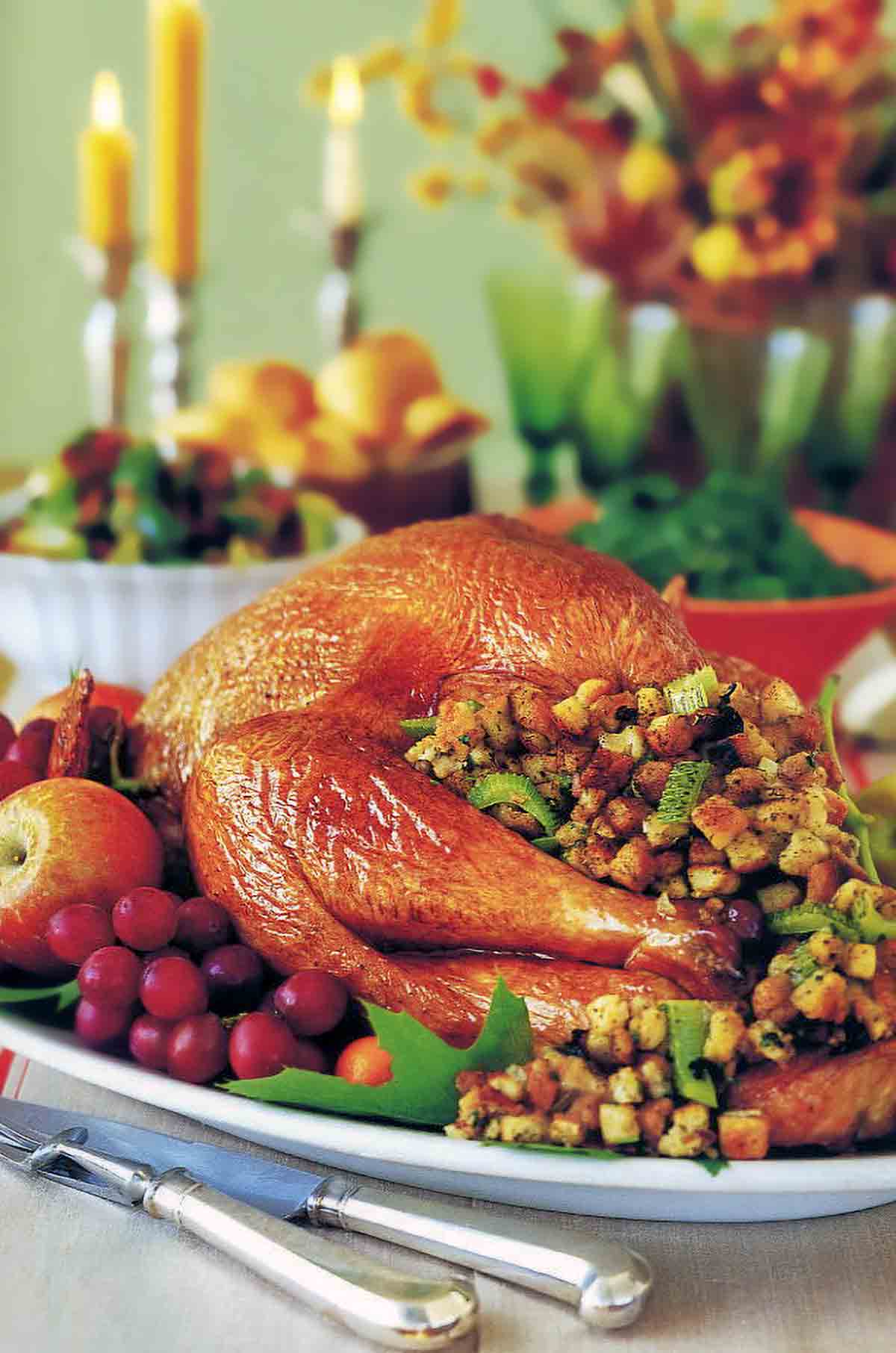
It seems a pity to relegate the roasting of a stuffed turkey—an exceedingly flavorful, moist bird—to one day a year. We eat turkey sandwiches year-round, and we never think twice about roasting a chicken throughout the seasons, but turkey has a bad rap as a complicated, time-consuming bird to prepare.
Not true. We like to find a smallish turkey and roast it in mid-February, when we could all use a little celebration. And the leftovers make many great turkey meals.
For our old-timey roast turkey, we stuff our bird with a simple bread stuffing flavored with lots of herbs, sauteed onions, garlic, and crunchy celery and surround it with chunks of peeled carrots, parsnips, and onions.
Notes on Ingredients
- Whole turkey–A 10-to-15-pound bird is perfect for this recipe as it will feed a crowd and hold an ample amount of stuffing. When buying a turkey, keep in mind if you choose a frozen one, you’ll need to allow several days for it to thaw.
- Vegetables–We like the combination of carrots, parsnips, and onions here, but you could use turnips, potatoes, or sweet potatoes if you prefer.
Step-by-Step Instructions
- Prepare the turkey. Let the turkey rest at room temperature while you preheat the oven to 450°F. Remove the gizzard, heart, neck, and liver, and rinse and pat the turkey dry.
- Stuff the turkey. Season the turkey inside and out, then loosely fill it with stuffing, taking care not to overstuff.
- Make the basting butter. Sauté the garlic cloves in butter, and brush some over the turkey, along with a sprinkle of paprika.
- Roast the turkey. Cook the turkey for 30 minutes, then reduce the oven temperature to 350°F and continue to roast, basting with garlic butter every hour, until the internal temperature of the turkey and stuffing is at least 165°F.
- Roast the vegetables. When the turkey has about 1 hour left, scatter the vegetables around it. Cook, stirring occasionally until tender.
- Make the turkey stock. While the turkey is roasting, combine the reserved neck, gizzard, and heart in a saucepan with the carrot, onion, celery, parsley, bay leaves, and peppercorns. Cover with plenty of water and simmer for a couple of hours to make your turkey stock.
- Make the gravy. Once the turkey and vegetables are finished roasting, transfer them to a serving platter. Skim off any fat from the drippings, then place the roasting pan over two burners and whisk the flour into the drippings. Slowly strain half the stock into the drippings, whisking to combine.
- Cook the gravy. Simmer the gravy until thickened, adding more stock if needed to thin it. Season with salt and pepper.
- Serve the turkey. Remove the stuffing from the turkey and transfer to a serving bowl. Carve the turkey and serve with the roasted vegetables, stuffing, and gravy.
FAQs
When cooking stuffing inside a turkey, it must be cooked to an internal temperature of 165°F to be safely enjoyed. The best way to check this is with an instant-read thermometer.
Scoop any extra stuffing into a buttered baking dish. You can bake it alongside the turkey for the final 45 minutes of roasting, or pop it into the oven while the turkey is resting.
Plan on at least 1 pound of turkey per person, and if you want leftovers, increase that number to 1 1/2 pounds.
Want to Save This?
Pro Tips & Troubleshooting
- To keep your stuffing from falling out of the turkey, stick a piece of sandwich bread over the opening of the cavity.
- To get ahead, you can make your turkey stock up to 3 days in advance.
- Leftover turkey, stuffing, and gravy can be stored in the fridge in sealed containers for up to 4 days.
Write a Review
If you make this recipe, or any dish on LC, consider leaving a review, a star rating, and your best photo in the comments below. I love hearing from you.–David
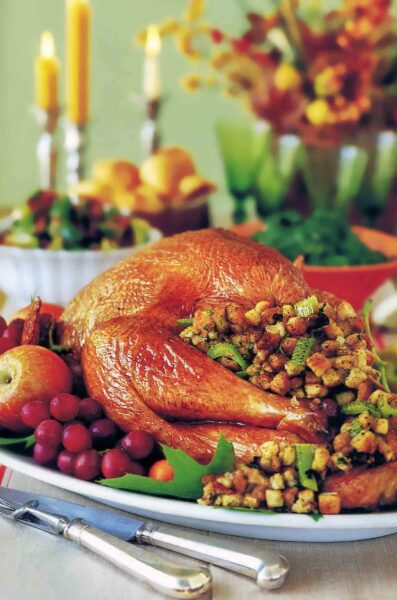
Roast Turkey with Stuffing and Vegetables
Ingredients
For the roast turkey
- One (10-to-15-pound) turkey, preferably organic
- 1 tablespoon vegetable oil
- Salt and freshly ground black pepper
- Herbed Bread and Celery Stuffing
- 1 slice bread
- 1/4 cup unsalted butter
- 12 garlic cloves, peeled, left whole
- About 1 teaspoon sweet Hungarian paprika
For the roasted vegetables
- 8 medium carrots, peeled and cut into 2-inch pieces
- 8 medium parsnips, peeled and cut into 2-inch pieces
- 8 medium yellow or red onions, halved
- Salt and freshly ground black pepper
For the gravy
- Turkey gizzard, heart, and neck
- 1 medium carrot, chopped
- 1 medium onion, quartered
- 1 stalk celery, chopped
- A few sprigs flat-leaf parsley
- 1 bay leaf
- 6 peppercorns
- Salt and freshly ground black pepper
- 2 to 3 tablespoons all-purpose flour
Instructions
Prepare the turkey
- Remove the turkey from the refrigerator about 1 hour before roasting, while you make the stuffing.
- Arrange the racks in the oven so the turkey will fit on the middle shelf. Preheat the oven to 450°F (230°C).
- Rinse the turkey under cold water. Remove the neck, gizzard, and heart and set aside to make the gravy. Remove the liver and save for another use. (The liver is delicious lightly coated in flour and then sauteed with 1 teaspoon butter in a skillet over medium-high heat for 5 to 6 minutes per side.) Pat the turkey dry with paper towels.
- Use the vegetable oil to lightly grease the bottom of a large roasting pan. Season the turkey with salt and pepper, inside the cavity and on the outside.
- Loosely stuff both the body and neck cavities of the turkey with the stuffing, pressing down but being careful not to overstuff the turkey. Press the slice of bread into the cavity at the wide opening to keep the stuffing inside so it won't fall out while the turkey roasts. Place the turkey in the roasting pan, breast side up.
- In a medium skillet, heat the butter over low heat. Add the garlic cloves and cook for 5 minutes, until the butter has completely melted and the garlic is just beginning to turn light golden brown. Remove from the heat.
- Using a spoon or a barbecue or pastry brush, brush the skin of the turkey with some of the garlic butter, reserving the rest to baste with later, and scatter at least half the garlic cloves around and on top of the turkey. Sprinkle the top of the turkey with the paprika.
- Using a piece of kitchen string, tie the legs together to keep them from touching the sides of the roasting pan. (Tying the legs also makes for a "neater"-looking roasted turkey.)
- Place the pan in the oven and roast for 15 to 20 minutes per pound, depending on the freshness of the turkey, or 2 hours 30 minutes to 3 hours 20 minutes for a 10-pound turkey or 3 hours 45 minutes to 5 hours for a 15-pound turkey. (Fresh turkey tends to cook much faster than those that have been frozen.) After 30 minutes, reduce the heat to 350°F (175°C). Baste the turkey every hour or so with the remaining garlic and butter and with the liquids that have accumulated on the bottom of the roasting pan.
- When you've estimated that the turkey has about 1 hour remaining to roast, place the carrots, parsnips, and onions in a bowl and season with salt and pepper. Scatter the vegetables around the turkey. (If there isn't a lot of room left in your roasting pan, place the vegetables in a well-oiled baking pan and place on the rack below the turkey.)
- Roast for 1 hour, stirring the vegetables once or twice so they brown evenly on all sides. If the turkey skin appears to be browning too quickly, cover the turkey very loosely with aluminum foil.
- Test for doneness. The turkey should be a gorgeous golden brown; when you wiggle a drumstick it should feel slightly loose; an instant read thermometer inserted into the thickest part of the thigh should read between 170°F and 180°F (76°C and 82°C), and when you pierce the skin directly above the wing the juice should run clear yellow, not pink. Gently remove the turkey from the roasting pan and place on a serving platter; cover loosely with aluminum foil.
Make the gravy
- Place the reserved gizzard, heart, and neck in a medium saucepan. Add the carrot, onion, celery, parsley, bay leaf, peppercorns, and 1/8 teaspoon salt and pepper to the pot and cover with about 6 cups of cold water. Bring to a boil over high heat, reduce the heat to low, and simmer for about 1 to 2 hours to make a light turkey stock that will be the basis of your gravy.
- To finish the gravy, once you've removed the turkey from the pan, remove any excess fat from the pan by tilting it to one side and spooning it off, being careful not to remove any of the natural juices. Place the roasting pan over two burners over moderate heat. Use a spatula to loosen any bits clinging to the bottom of the roasting pan.
- Sprinkle on the flour and, using a whisk, mix the flour with the juices in the bottom of the pan. Cook for 1 minute, stirring until the paste has come together and is beginning to turn a pale golden color. Pour a little more than half of the turkey stock through a sieve into the pan and whisk to create a smooth gravy.
- Simmer for 5 to 10 minutes, until slightly thickened and flavorful. Thin the gravy by adding additional stock as needed. Season to taste with salt and pepper. Keep the gravy warm over low heat, stirring occasionally until ready to serve.
- Remove the stuffing from the turkey and place in a serving bowl. Carve the turkey and serve with the roasted vegetables and hot gravy.
Notes
- Baking extra stuffing–If your stuffing doesn’t all fit into the cavity of the turkey, place it in a baking dish and cook alongside the turkey for the final 45 minutes.
- Get ahead–The turkey stock can be prepared up to 3 days before cooking the turkey.
- Storage–Leftover turkey, stuffing, vegetables, and gravy can be stored in sealed containers in the fridge for up to 4 days.
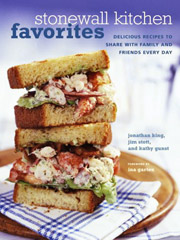
Explore More with AI
Nutrition
Nutrition information is automatically calculated, so should only be used as an approximation.
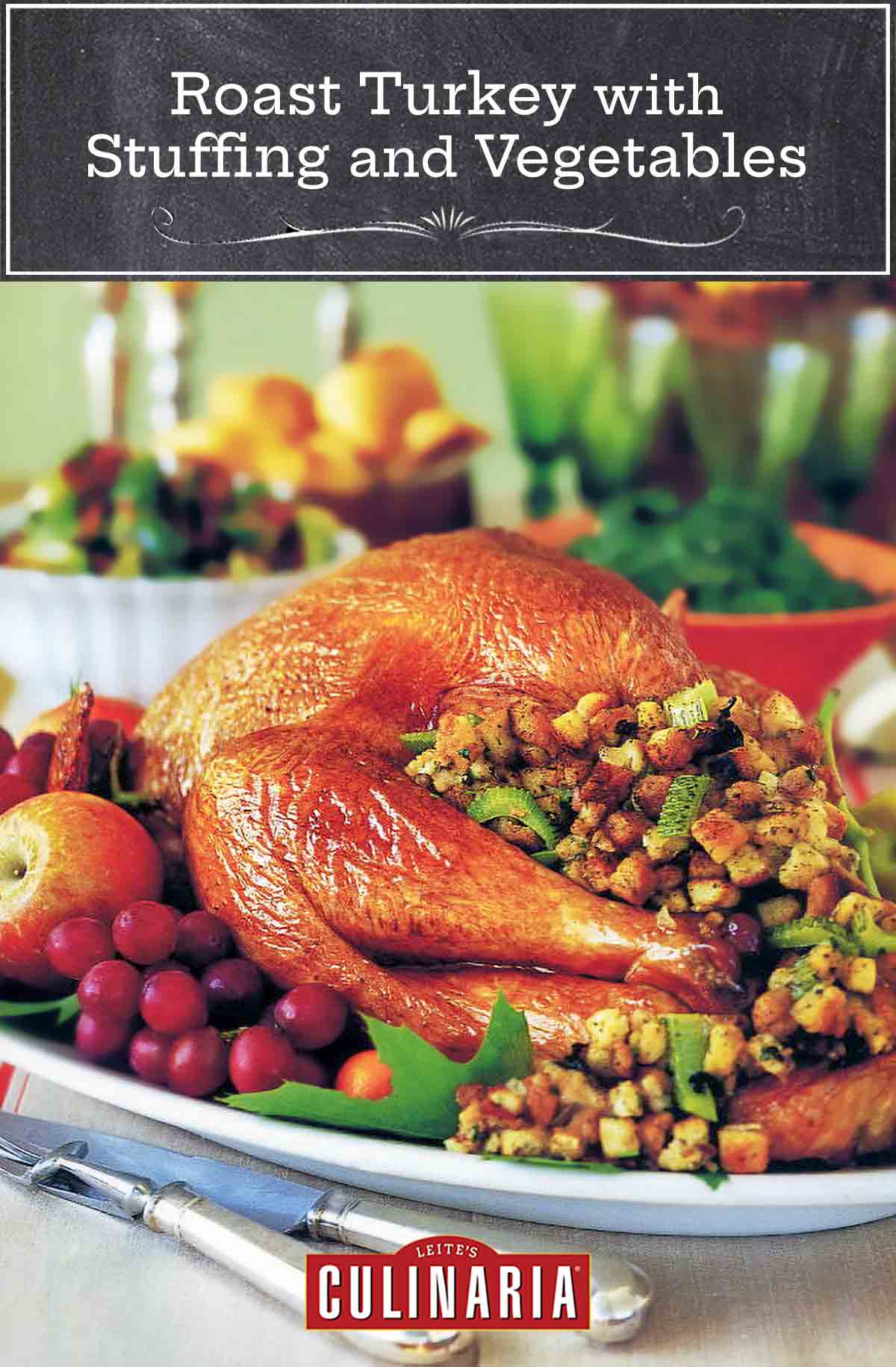
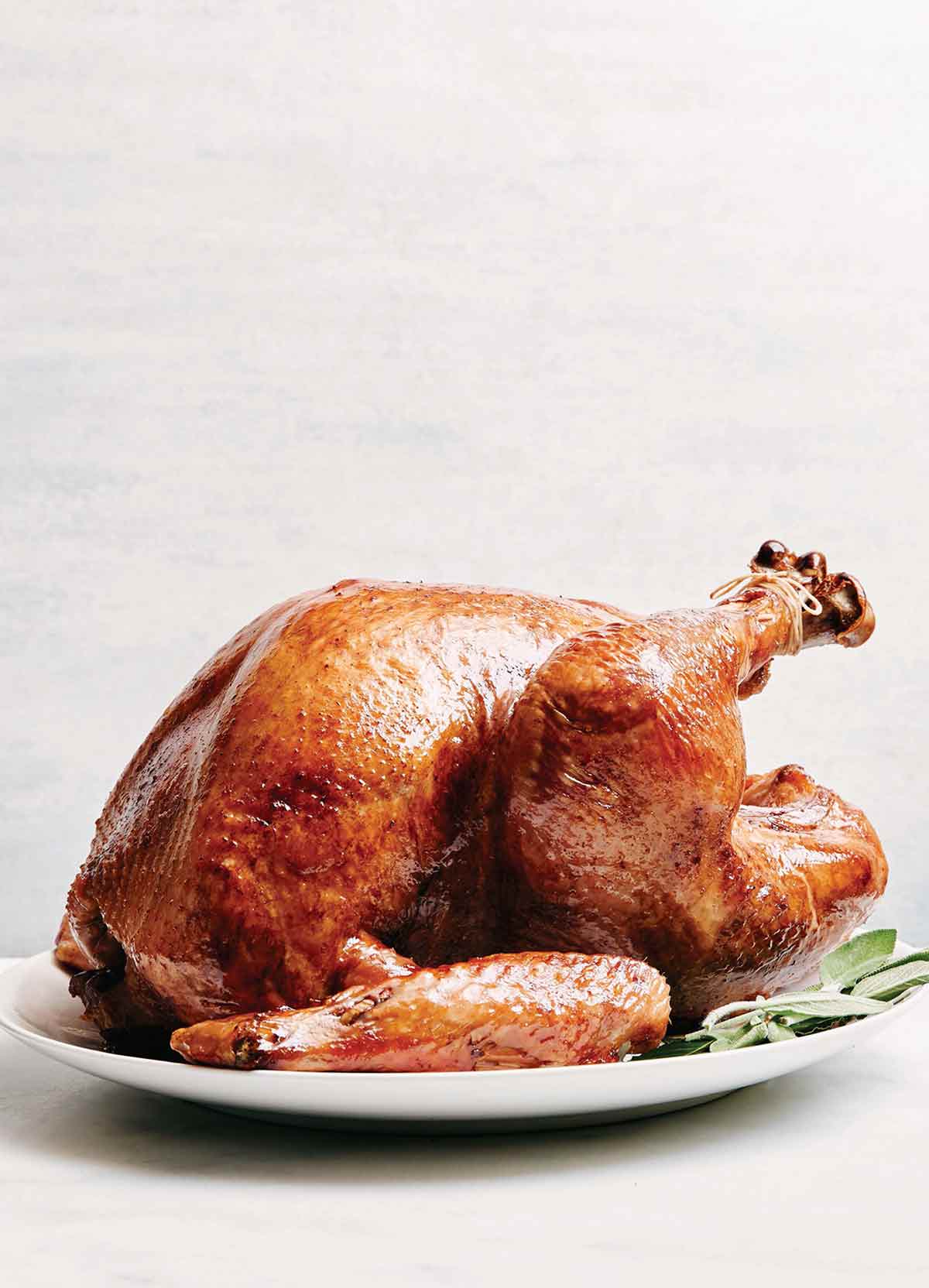
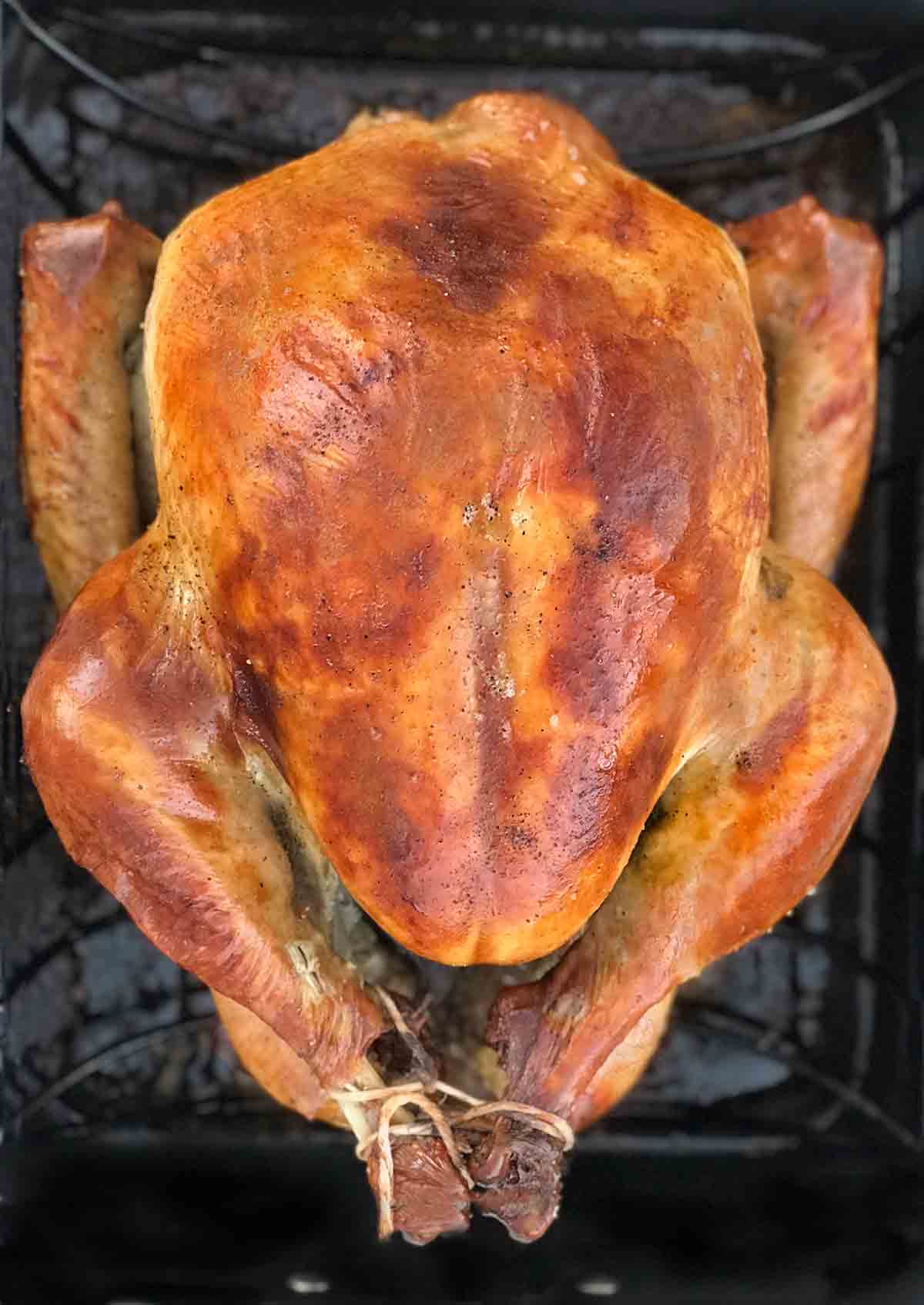










As a kid I always had stuffing in the turkey, but nowadays it seems to always be made as a side dish. Most recipes I see say that by the time the stuffing is to temperature the meat will be overcooked. How does this recipe get around that, or is that one of those myths that take over for a while and everyone thinks it’s true even if it’s not?
Jim, you have a good eye! It’s not a myth: Stuffing a turkey is questionable. If not cooked fully, it can be a breeding ground for salmonella. I think where many cooks go off the rails is they make the stuffing ahead of time, refrigerate it, and then stuff it into a cold bird. So cold stuffing in a cold turkey. This recipe calls for the cook to take the turkey out of the fridge an hour before and stuff it with the warm, just-made stuffing. So the stuffing gets a head start. I hope this helps.
I’ve been obsessed with stuffed turkey recipes for the last 20 years, trying to perfect it year after year.
This recipe is exactly what I was looking for. Regarding the sandwich bread over the stuffing–how does it affect the stuffing itself, texture, taste, and cooking? It seems simple enough, but not familiar with this method.
Jessia, I’m delighted you found the recipe. As far as the bread method, it doesn’t affect flavor, texture, or cooking time. It’s just a way of keeping the stuffing from falling out and dying out.